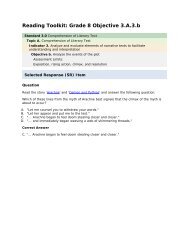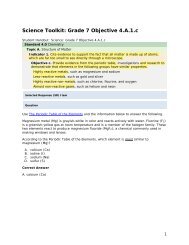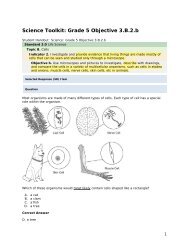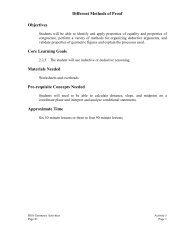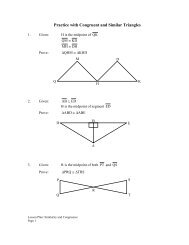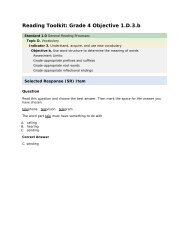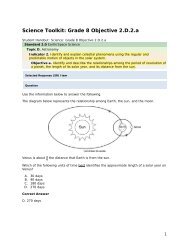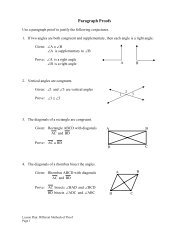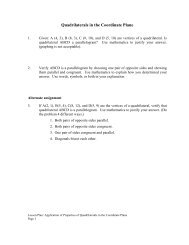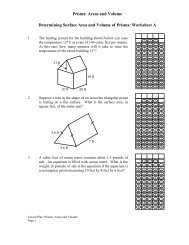Reading grade 5 2.A.4.c - mdk12
Reading grade 5 2.A.4.c - mdk12
Reading grade 5 2.A.4.c - mdk12
Create successful ePaper yourself
Turn your PDF publications into a flip-book with our unique Google optimized e-Paper software.
<strong>Reading</strong> Toolkit: Grade 5 Objective <strong>2.A.4.c</strong><br />
Student Handout: <strong>Reading</strong>: Grade 5 Objective <strong>2.A.4.c</strong><br />
Standard 2.0 Comprehension of Informational Text<br />
Topic A. Comprehension of Informational Text<br />
Indicator 4. Determine and analyze important ideas and messages in informational<br />
texts<br />
Objective c. State and support main ideas and messages<br />
Assessment Limits:<br />
In the text or a portion of the text<br />
Selected Response (SR) Item<br />
Question<br />
Read this article titled "Snug in the Snow." Then answer the question below.<br />
What is the main idea of paragraph 6 of this article?<br />
A. Snakes, turtles, and frogs are cold-blooded animals.<br />
B. Frogs cover themselves in mud to get out of the cold.<br />
C. Cold-blooded animals hibernate because they cannot warm themselves.<br />
D. Animals often hibernate in groups in sheltered places, like rotted-out logs.<br />
Correct Answer<br />
C. Cold-blooded animals hibernate because they cannot warm themselves.<br />
1
<strong>Reading</strong> Toolkit: Grade 5 Objective <strong>2.A.4.c</strong><br />
Question<br />
Read this article titled "Snug in the Snow." Then answer the question below.<br />
What is the main idea of paragraph 6 of this article?<br />
A. Snakes, turtles, and frogs are cold-blooded animals.<br />
B. Frogs cover themselves in mud to get out of the cold.<br />
C. Cold-blooded animals hibernate because they cannot warm themselves.<br />
D. Animals often hibernate in groups in sheltered places, like rotted-out logs.<br />
2
<strong>Reading</strong> Toolkit: Grade 5 Objective <strong>2.A.4.c</strong><br />
Handouts<br />
Snug in the Snow<br />
What happens to animals when the days get shorter and the<br />
snow starts to fly? Many head for warmer climates. Others get<br />
ready for winter by putting on a thick coat of fur. Some animals<br />
head underground for a long winter's nap. This is called<br />
hibernation. These hibernators go into a deep sleep. If you saw a<br />
hibernating animal you might think it was dead.<br />
Sleeping all winter takes preparation and animals that<br />
hibernate begin preparing for it in the fall. They try to put on as much fat as possible<br />
because they won't be eating much during the winter. Animals that hibernate also put on a<br />
special kind of fat, called brown fat. This special fat is found across the back and shoulders<br />
of hibernating animals, close to an animal's organs (brain, liver). Brown fat works fast to<br />
deliver quick energy to an animal coming out of hibernation.<br />
Hibernation is still a bit of a mystery for scientists. How does an animal know when it's<br />
time to get ready for hibernation? How does their body know to slow down during<br />
hibernation? Scientists have found a special substance in the blood of hibernating animals.<br />
It's called HIT (Hibernation Inducement Trigger). If blood is taken from a hibernating<br />
ground squirrel in the winter and injected into an active squirrel in the spring, the active<br />
squirrel goes into hibernation. (Pretty weird, huh?)<br />
There are different kinds of hibernation. The "true" hibernators sleep so deeply that they<br />
are almost impossible to wake up. Woodchucks, ground squirrels and bats are "true"<br />
hibernators. A woodchuck's heart rate goes from 80 beats a minute when active to 4 or 5<br />
beats a minute when in hibernation.<br />
Its body temperature drops from 98 degrees Fahrenheit to 38<br />
degrees Fahrenheit. And the woodchuck's incisors, which grow<br />
continuously and are kept short by all the gnawing it does, quit<br />
growing during hibernation. True hibernators do get up every few<br />
weeks to nibble on food, and in the case of the woodchuck, use<br />
an underground toilet room. When bats are ready to hibernate,<br />
they must find a place that stays above freezing. They gather<br />
together in caves called hibernacula.<br />
Bears are not "true" hibernators. They are one of the "light sleepers." They are easily<br />
awakened from their winter slumbers. These in-between hibernators are simply taking long<br />
winter naps. Skunks, raccoons, and opossums are also in this group. These animals breathe<br />
a little more slowly and lower their body temperature a few degrees while sleeping, but they<br />
wake up to forage between winter snows.<br />
6 Can you think of any other animals that hibernate? How about our cold-blooded<br />
friends"snakes, turtles, and frogs? Since cold-blooded animals can't warm themselves up,<br />
they need to find a way to protect themselves from the cold. Frogs and turtles bury<br />
themselves in the mud below the frostline. They get oxygen from air trapped in the mud. In<br />
the spring when the sun warms the mud, out they'll come. Some snakes head underground<br />
to hibernate; others gather together in sheltered places, like rotted out logs. Imagine<br />
3
<strong>Reading</strong> Toolkit: Grade 5 Objective <strong>2.A.4.c</strong><br />
walking in the woods on a spring day and coming across a bunch of snakes emerging from<br />
their wintering spot. What a sight that would be!<br />
Hibernation is still somewhat of a mystery and an amazing animal adaptation. 1 The next<br />
time you're sitting around the fireplace all snug, warming up after playing outside, think<br />
about all the animals that are sleeping, snug in the snow.<br />
1 adaptation " a change in behavior to fit a special situation<br />
© by EEK! Environmental Education for Kids, Wisconsin Department of Natural Resources.<br />
4




